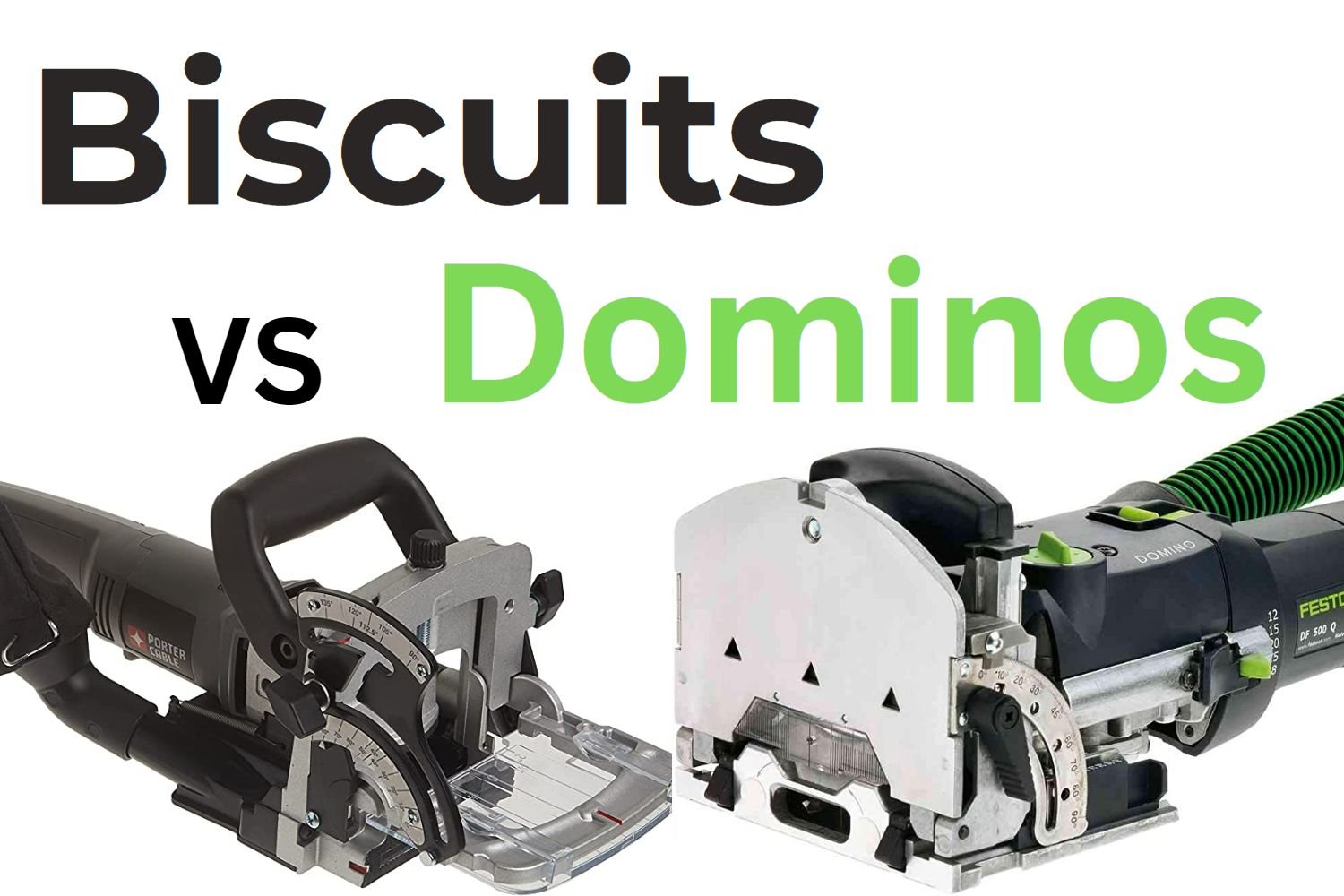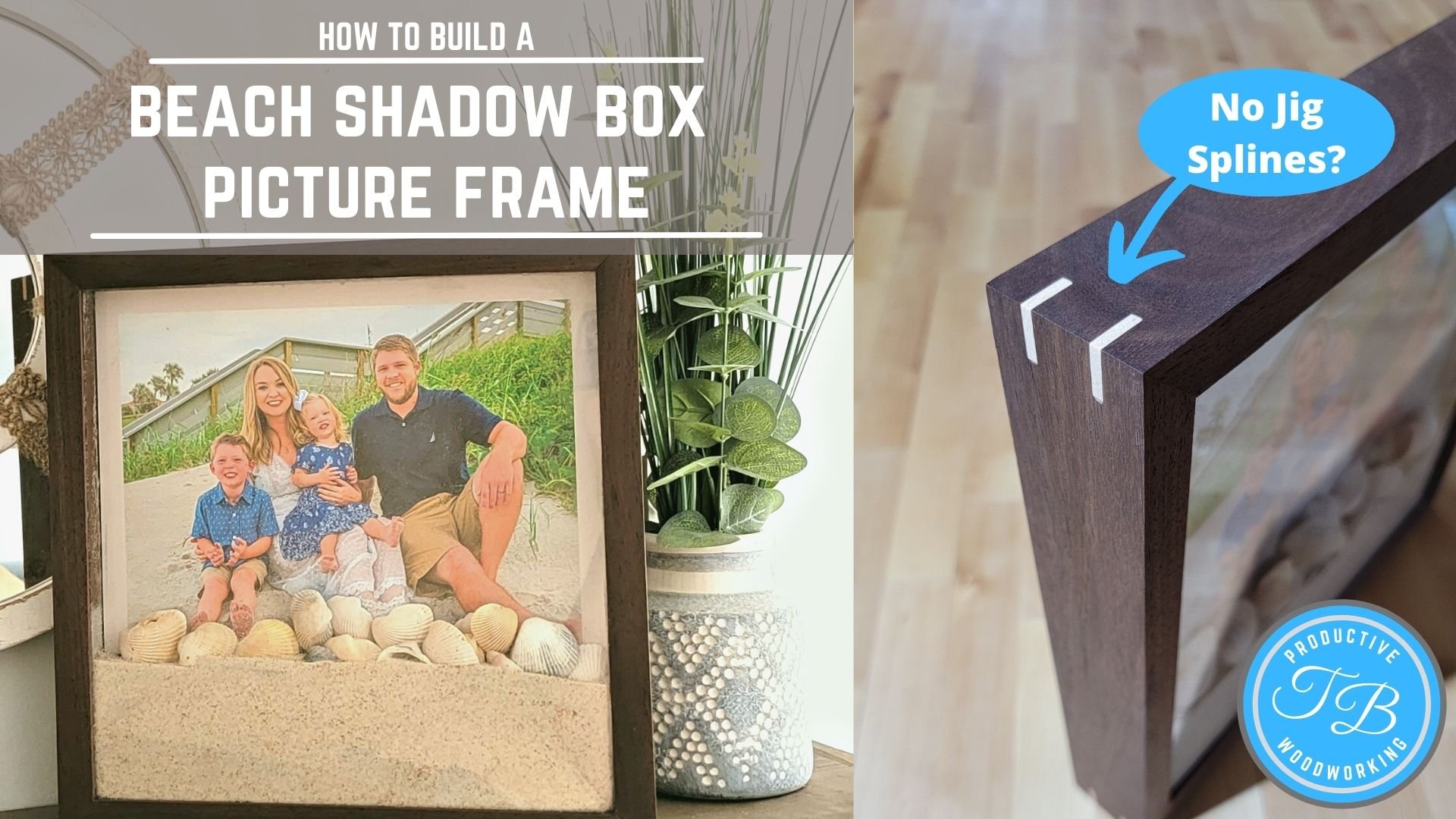Festool Domino Joiner vs Biscuit Joiner
When looking at the differences between the Festool Domino joiner vs a biscuit joiner you need to look at the joining methods more than the tools themselves. Each of the woodworking tools creates a different type of joinery which is designed for different purposes. I’ve written a complete hands-on review of the Festool Domino, which I have been using for years and it has been a complete game changer. So, if you are looking to buy a joinery machine this article will help you decide if the kind of work that you do justifies the cost of a Festool Domino or if the best option is a biscuit joiner.
Affiliate links are used on this page. See my disclosure page for info on affiliate programs. The links do not cost anything extra to you! I receive a small percentage from the businesses you purchase from which help support creating content and helpful articles like this one!
Joinery Methods
Biscuit Joinery
A biscuit joint is one of the many types of joinery in woodworking and is one of the easiest ways to align two pieces of wood. The joint is made by using a hand-held jointer which uses a carbide blade to cut a slot in the edge of a board as well as in the same location as the corresponding board. Then you can insert a biscuit which is just a thin oval-shaped piece of wood into the slot along with some glue and clamp the wood together until the glue dries. Biscuit joinery creates a seamless joint and helps align the panels with ease. A biscuit joiner is mostly used to create panel glue ups, table tops, and alignment purposes.
Domino Joinery
Domino Joinery is a modern take on traditional mortise and tenon joinery that is specific to new products offered by Festool. Festool had engineered a new type of joint that uses proprietary Domino tenons and their Domino machines. The joint is created by first using a Festool Domino joiner that uses a cutter similar to a router bit to cut a mortise into a workpiece and on the corresponding location of the other piece of wood. Next, a Domino which is Festool's proprietary loose tenon is then inserted into the mortise and glued on both ends while the workpieces are clamped together. Domino joinery is typically used to create structural components and is a popular choice of joinery by professional woodworkers.
Dominos Vs Biscuits
Strength
When looking at both Domino and biscuit joinery the major difference between the two is joint strength. Domino joinery provides extra strength due to its ability to use long floating tenons rather than biscuits essentially mimicking traditional mortise and tenon joints. The smaller domino joiner can cut 28mm or 1-2/8 inch deep mortises and the larger domino can cut up to 70mm or 2-3/4 inches. In comparison, the largest biscuit available is the #20, which is only 22mm wide and only allows for 11mm or 4/16 of an inched into each of the workpieces not providing much strength to the joint. Dominos also have a large gluing surface area in comparison to biscuits and can easily be used in end grain without issues. Since dominos offer structural integrity they can be used on composite wood like MDF, particle board, or plywood whereas biscuits would not hold up under stress. If you're looking for the strongest joinery method the Domino is the better choice.
Alignment
Biscuit jointers are widely known to be used for alignment purposes and if you are looking for a tool primarily to help align panels for glue-ups the biscuit joiner is a good choice. However, the Festool Domino 500 and 700 can also be used for alignment. Biscuit joiners were designed specifically to use thin biscuits, whereas the Domino joiner works in the same fashion just using thicker domino tenons. Domino joints are definitely overkill for alignment but the Festool is able to adjust the mortise width. The Domino Joiners are capable of creating wider mortises to account for misaligned panels or human error when marking your workpieces. I find this setting to be very helpful and speeds up the process of gluing panels by not having to worry about precision. When it comes to There isn't much difference in the accuracy or performance between a biscuit joiner vs a domino joiner when it comes to alignment. However, if you use a biscuit joiner of low quality you could experience some issues with alignment.
Ease Of Use
I personally believe the Festool Domino DF 500 is a game changer when it comes to simplifying traditional mortise and tenon joinery. Dominos are able to be used for simple butt joints, edge joining panels, and miter joints. As long as you take the time to correctly mark each of the workpieces the domino tools will produce flawless structural floating tenon joints. I personally have quickly and easily built face frames for cabinetry, complex table legs, and stools with dominos with ease. Biscuit joiners are similarly easy to operate with very minimal setup and almost identical operations as the Domino. They too can be used for butt joints, edge joining panels, and miter joints but due to the thin nature of biscuits, I would not consider using them in structural joints. In comparison, I would say it's easier to use the biscuit joiner, but only due to its limited functionality and capabilities.
Biscuit & Domino Sizes
Both Dominos and Biscuits come in a variety of sizes each with a specific purpose and use case. The Festool Domino comes with the ability to use various-sized cutters, ranging from 4mm to 14mm, which is referring to the thickness of the floating tenon. Festool makes various-sized Dominos that fit each of the mortises cut by the machines, you could however make your own loose tenons but it would take some time. The smaller dominos are able to join wood as thin as 5/16 of an inch while still offering structural integrity, while the larger tenons can be used for heavy-duty structural applications. Biscuits come in 3 main sizes named #0, #10, and #20 which are all 4mm in thickness and range in size from 47mm to 56mm in length and 15m to 23mm in width. Some joiners are capable of using the smallest biscuits available which is an #FF. The #FF biscuits measure 30 x 33mm in size and are primarily used for small projects. The table shows the various sizes of dominos and biscuits available and highlights the capabilities of the Festool Domino due to the number of options and size of mortises the machine can cut.
| Biscuit Sizes | Metric | Imperial |
|---|---|---|
| #FF | 30 x 13 mm | 1-13/64 x 1/2 |
| #0 | 47 x 16 mm | 1-27/32 x 5/8 |
| #10 | 52 x 20 mm | 2-3/64 x 3/4 |
| #20 | 58 x 24 mm | 2-1/4 x 1 |
| Domino Size | DF 500 | DF 700 |
|---|---|---|
| 4 x 20 mm | X | |
| 5 x 30 mm | X | |
| 6 x 40 mm | X | |
| 8 x 40 mm | X | X |
| 8 x 50 mm | X | X |
| 8 x 80 mm | X | |
| 8 x 100 mm | X | |
| 10 x 50 mm | X | X |
| 10 x 80 mm | X | |
| 10 x 100 mm | X | |
| 12 x 100 mm | X | |
| 12 x 140 mm | X | |
| 14 x 75 mm | X | |
| 14 x 100 mm | X | |
| 14 x 140 mm | X |
Tool Comparison
Cost
The price difference between a biscuit joiner vs a Domino joiner can be steep. A quality biscuit joiner is cheaper than the Festool Domino but in the long run, a Festool Domino DF 500 may justify the cost. A biscuit joiner or plate joiner is a relatively cheap tool with prices ranging from $50 to $200+ depending on the brand. I personally would stay away from the cheaper tools and stick with something of higher quality like the Dewalt biscuit joiner or one from Porter Cable. The Festool Domino is definitely higher cost and a superior tool with prices near a thousand dollars for the DF 500 Q-Set and a few hundred more for the Domino XL DF 700. I have written a complete outline of all differences between the Domino models which could help you decide which is best for you. One downside of the Domino system is the Domino requires the use of a dust extractor which adds to the cost if you don't already have one in your woodworking shop. Most can agree that Festool products are high-end tools, but the question is can you justify the extra cost? The following sections will outline the key differences between the tools to see which is more cost effective for your woodworking.
Capabilities
When comparing the Domino joiner vs a biscuit joiner there are some similarities between the tools, but the Festool Domino is a game changer. Typically I never read the user manual when I buy a new tool but due to all the different capabilities and features of the Domino Joiner, I made sure to read it. The Domino is capable of using various-sized cutters and has adjustments for mortise width and depth to create strong joints regardless of the material thickness. The ability to cut various-sized mortises sets itself apart from a standard biscuit joiner which is only adjustable for depth and only to a minimal degree. The Domino joiner is a powerful tool capable of producing joinery for large projects as well as simple butt joints. Biscuit joiners have been an invaluable tool for woodworkers for a long time, yet the tool is limited in its uses. Primarily biscuit joiners are used for the alignment of panels, glue-ups, and non-structural applications or to reinforce narrow joints like picture frames. Both the joinery tools have the same design of fences with tilting features as well as height adjustments.
Ease of Use
The Festool Domino has a lot of similarities with a traditional biscuit joiner. The fence systems are nearly identical with a sliding fence for height adjustments as well as tilting for angled mortises or biscuit slots. Also, the mechanism of plunging the tool into the workpiece is very similar. However, that is about where the similarities end when you look at how easy it is to use the machines. The Domino has multiple reference points with retractable pins built into the base as well as cross stops that attach to the sides for quick indexing. Also, the process to swap out the domino cutters is very simple with the process taking less than a minute. Both machines offer dust extraction and work extremely well, however finding adapters for the various biscuit joiners may be hard to find. I personally have found using the Domino extremely easy and I have built a lot of furniture with no issues.
Conclusion
In comparison, both joinery tools are designed for different things with some overlaps in between. The Festool Domino has changed the way the woodworking community looks at mortise and tenon joinery, by making it easier to accomplish and fast, which I outline in my review of the DF500. The biscuit joiner is a great way to quickly align pieces with biscuit slots. The main difference between the biscuit joiner vs domino is the domino joiner is able to create very strong joints for structural components where as a biscuit joiner is primarily for alignment. Either machine would be a great investment for your woodworking shop but you need to pick the right tool for your woodworking projects. Personally, since buying the Festool Domino DF 500 I have not seen the need for a biscuit joiner, the only downside is the cost of the Domino joiner. If you are looking for a power tool to help with alignment then look at the biscuit joiner. If you plan to build woodworking projects that require structural joinery you should get a Festool Domino joiner.
Frequently Asked Questions
Are pocket holes better than Dominos?
When comparing pocket screws to dominos the domino joint is stronger by far. Pocket hole jigs are great for joinery that is not structural in nature and only require minimal holding force like face frames or cabinet construction. I recommend to only use pocket screws when you know the joinery is going to be covered or hidden. I personally started woodworking with a Kreg jig, which is an easy way to get into woodworking without a lot of tools. Even to this day I still use pocket hole joinery when building cabinets and simple woodworking projects.
Is dowel joinery better than Dominos?
Domino joinery in comparison to the dowel joint is superior in strength and longevity. Domino tenons have a larger surface area for glue and are typically made of dense wood while pre-made dowels do not. However, if you are just starting out woodworking a doweling jig and good brad point drill bits are a great starting point. I personally used a doweling jig for panel alignment and as an alternative to a biscuit joiner and a Domino joiner.
What are the best alternatives to the Festool Domino?
There are quite a few alternatives to the Domino joiner, and I compiled a complete list of tools and best applications in another article. Yet, none offer the same capabilities or ease of use as the Festool Domino. You could come close to the Domino with a dowel joiner yet the strength of the joint may suffer. Also, if saving time is not a factor you could create traditional mortise and tenon joinery with a table saw and stationary mortising machine.
Festool Domino VS Lamello Zeta P2?
You may be wondering since a traditional biscuit joiner is not as versatile as a Festool Domino, what about the Lamello Zeta P2? The Lamello biscuit jointer is very similar to a traditional joiner in that it routes a very thin slot yet it does so with deeper grooves inside the slot. This allows the use of specialized plastic biscuits that clamp the wood pieces together for simple knockdown-style connectors. The engineering behind the Lamello is incredible and offers the same precision as the Domino System yet lacks in its ability to perform structural joinery. Also, the new products offered by Festool that include metal anchors, bolts, and connectors seemingly offer the same functionality as the Lamello but with stronger components.
If you have any questions, comment below.
Let’s talk about it!



















